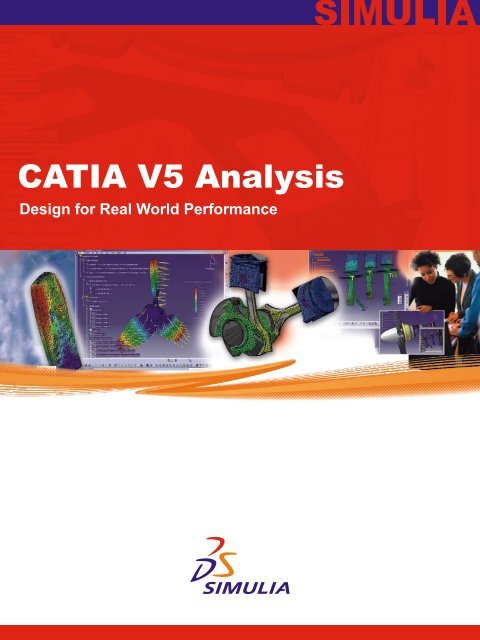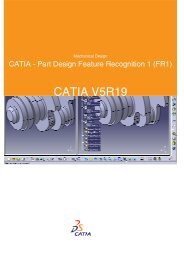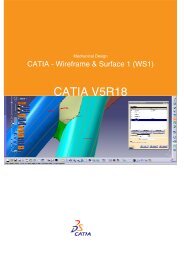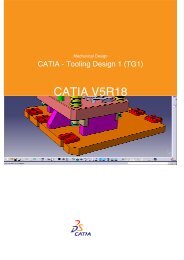CATIA V5 Analysis - PLM
CATIA V5 Analysis - PLM
CATIA V5 Analysis - PLM
You also want an ePaper? Increase the reach of your titles
YUMPU automatically turns print PDFs into web optimized ePapers that Google loves.
Capabilities to Meet the Needs of All Users• Designers: Use analysis to size parts and ensure that the design will work the first time• Analysts: Perform a virtual test to evaluate the performance of the design and whetherit will meet its requirements• Method Developers: Develop standardized analysis methods and then provide thosemethods to designers using templates and knowledgewareFast <strong>Analysis</strong> LoopDesigners• Familiar CAD environment• Geometry associativity• Automated, adaptive meshing• Template-based guidance• Knowledge-based designoptimization• Computation speed• Results reliability<strong>CATIA</strong><strong>V5</strong><strong>Analysis</strong>AnalystsDetailed <strong>Analysis</strong>• CAD integration• Rapid model building and results evaluation• Meshing performance and control• Easy update after design change• Large model capacity• Solver performance and flexibility• Open to multiple applicationsMethod DevelopersProcess Automation• Knowledge-based architecture• Capture of analysis methods and knowledge• Templates to deploy standard analysis methodsWhy Choose <strong>CATIA</strong> <strong>Analysis</strong>?<strong>CATIA</strong> <strong>Analysis</strong> allows designers who are using <strong>CATIA</strong> to leveragethe power of proven analysis technology to evaluate and improvetheir designs. It also provides the technology for engineeringanalysts to create complex finite element models whilemaintaining associativity with the master design in <strong>CATIA</strong>, therebyavoiding time-consuming and error-prone transfer of geometry.“Using <strong>CATIA</strong> <strong>Analysis</strong>, a designer rather than anexpert is now able to perform an analysis on anautomobile transmission gear assembly. In the past,such an analysis would only take place if seriousproblems requiring design modification occurred…With today’s improved CAE tools, however, allanalysis conditions for the gear assembly can beset within 30 minutes.”—Dr. Takanao Uchida, leader of the <strong>CATIA</strong> <strong>V5</strong> project atHonda Automotive R&D and one of the pioneers of “DesignerCAE” in Japan
Features and Benefits:• User-friendly environment• Fast design-analysis loops• Multidiscipline collaboration• Knowledge-based optimization• Industry-proven performanceUser-friendly environment<strong>CATIA</strong> <strong>Analysis</strong> provides designers and analysts with anintuitive user interface that meets their varied needs. Sincethe user interface is a natural extension of that in <strong>CATIA</strong>, itis particularly easy for <strong>CATIA</strong> users. They obtain a realisticunderstanding of the mechanical behavior by quickly reviewingdesign characteristics in a digital mockup (DMU) environment.The <strong>CATIA</strong> <strong>V5</strong> tools and environment—that are common to all<strong>CATIA</strong> applications, Abaqus for <strong>CATIA</strong>, and partner solutions—eliminate the problem of lost productivity associated with usingmultiple applications.Fast design-analysis loopsThe analysis specifications are an extension of the part andassembly design specifications, and the analysis is performeddirectly on the <strong>CATIA</strong> geometry. It is, therefore, simple andconvenient to perform an analysis to help size parts andcompare the performance of different design alternatives.The impact of design changes can be rapidly assessedwith automatic updates. Designers using <strong>CATIA</strong> <strong>Analysis</strong>will naturally use analysis as part of their design process,affording them a greater understanding of how their designsperform and improving their ability to deliver the right designthe first time.Multidiscipline collaboration<strong>CATIA</strong> <strong>Analysis</strong> supports concurrent engineering, allowingusers to work closely together and avoid rework. Designersand analysts can collaborate since they have access to thesame environment, eliminating data transfer, rework, and theneed to maintain multiple applications for design and analysis.The analysis environment also allows method developers tocreate templates that designers can routinely use to performstandard types of analysis.Knowledge-based optimizationThe <strong>CATIA</strong> <strong>Analysis</strong> products leverage the native <strong>CATIA</strong>knowledge-based architecture. They allow designs to beoptimized by capturing and studying the knowledge associatedwith part design and analysis. The reuse of analysis featuresand the application of knowledge-based rules and checksensure compliance to company best practices. Automation ofstandard analysis processes through the use of knowledgewaretemplates dramatically improves the efficiency of the designanalysisprocess.Industry-proven performanceThe speed with which analyses can be performed in <strong>CATIA</strong>often surprises designers and simulation experts familiar withother applications. The time it takes to create the finite elementmodel, solve it, and display results can be a matter of minutes.The robust, built-in finite element solver and mesh generatorsbalance both accuracy and speed. The adaptive meshingcapability automatically adjusts the mesh to obtain accurateresults without time-consuming manual involvement.“With <strong>CATIA</strong>, it’s one click to move from design to analysis and then another click to move to NC (NumericalControl) programming. That’s invaluable because many of our engineers perform all three tasks, and theyonly have to learn one user interface. It has cut at least 50% off our development times.”—Steve Oliver, Director of Design Services, Gillett Evernham Motorsports
<strong>CATIA</strong> <strong>V5</strong> <strong>Analysis</strong> ProductsWorkbench – Generative Structural <strong>Analysis</strong>Generative Part Structural <strong>Analysis</strong> (GPS)Generative stress and modal analysis on single partsGenerative Assembly Structural <strong>Analysis</strong> (GAS)Generative stress and modal analysis on hybrid assembliesGenerative Dynamic <strong>Analysis</strong> (GDY)Generative structural dynamic response analysisELFINI Structural <strong>Analysis</strong> (EST)Complementary advanced options for preprocessing, solving, and postprocessingWorkbench – Advanced Meshing ToolsFEM Surface (FMS)Complementary advanced options to generate associative mesh from surface designFEM Solid (FMD)Complementary advanced options to generate associative mesh from solid designScalable SolutionsThe existing <strong>CATIA</strong> <strong>V5</strong> <strong>Analysis</strong> capabilities can be extendedto include basic nonlinear and thermal analysis by addingSIMULIA Extended <strong>Analysis</strong> to the existing portfolio. Partnerproducts also provide extended capabilities such as multibodydynamics, computational fluid dynamics, fatigue analysis, andothers.<strong>CATIA</strong> <strong>V5</strong> <strong>Analysis</strong> Capabilities• Linear stress analysis on parts and hybrid assemblies(solid, surface, and wireframe)• Transient and harmonic dynamic analysis• Contact analysis• Buckling analysis• Thermo-mechanical analysis• Modal analysis• Vehicle assembly analysis• Assembly of multiple analysis modelsAdditional capabilities with SIMULIA Extended <strong>Analysis</strong>• Thermal analysis• Nonlinear analysis• Thermal stress analysisComplementary solutions from CAA Partners• Acoustic analysis• Computational fluid dynamics (CFD)• Noise and vibration (NVH) analysis• Multibody dynamic analysis• Ride and handling analysis• Durability and fatigue analysis• Stamping analysis• Gateway interfaces to external solversFor further information on our partners, please visit:www.3ds.com/alliances/software-partnership
SIMULIA World Headquarters166 Valley StreetProvidence, RI 02909 USA+1 401 276 4400E-mail: simulia.info@3ds.comwww.simulia.comAbout SIMULIASIMULIA is the Dassault Systèmes brand that delivers a scalable portfolio of Realistic Simulation solutions including the Abaqus product suite for Unified Finite Element <strong>Analysis</strong>,multiphysics solutions for insight into challenging engineering problems, and SIMULIA SLM for managing simulation data, processes, and intellectual property. By building onestablished technology, respected quality, and superior customer service, SIMULIA makes realistic simulation an integral business practice that improves product performance,reduces physical prototypes, and drives innovation. Headquartered in Providence, RI, USA, SIMULIA provides sales, services, and support through a global network of regionaloffices and distributors.For more information, visit www.simulia.com.The 3DS logo, SIMULIA, <strong>CATIA</strong>, 3DVIA, DELMIA, ENOVIA, SolidWorks, Abaqus, Isight, Fiper, and Unified FEA are trademarks or registered trademarks of Dassault Systèmes or its subsidiaries in the US and/or other countries.Other company, product, and service names may be trademarks or service marks of their respective owners.Copyright Dassault Systèmes, 2009MAR_CAT_Y09
















